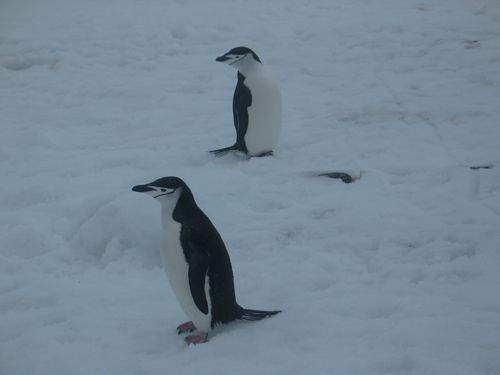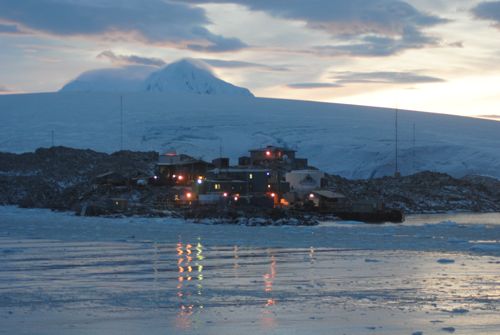I've gotten a lot of questions about Antarctica - the environment, wildlife, food, and activities down here. So let's cover the basics. Antarctica is the furthermost southern continent. It's where the South Pole is located. The Arctic is where the North Pole is located. Even though it is below the equator it is not warm down here. The poles are the coldest places on the earth. The warmth of equatorial countries has to do with the direct angle that the sun's rays are hitting the earth on a continuous basis. Since we are in the southern hemisphere, we are going into winter right now. The days are getting shorter. When you go below the Antarctic Circle you will have a period of time when it is dark all day long in the winter and a period of time in the summer (which down here is December) when the sun never fully sets. Antarctica is nicknamed the 'White Continent" because of it's snow, glaciers, and ice-covered terrain.
 This is Sidell Spur. It's named after the late Dr. Bruce Sidell. We made a point to visit it on our way down to Palmer Station.
This is Sidell Spur. It's named after the late Dr. Bruce Sidell. We made a point to visit it on our way down to Palmer Station.
It is extremely mountainous, which includes Mt. Erebus which is an active volcano. In fact, it is the world's southern most volcano. In fact, it is the highest, the windiest, the coldest, and the driest continent on earth. Can't get much further south than the South Pole. And yes, for those of you who asked, there is a marker designating where the actual South Pole is. I'm not that far south. I'm at -64.46 Latitude and -64.03 Longitude. The South Pole is -90.00 Latitude and the Antarctic Circle is -66.33. I'm spending my time on the Peninsula of the continent.
Misconception #1 Polar bears and Penguins live together. NOT! Never. Nowhere, well maybe at the zoo. Polar bears live in the Arctic, as in North. Penguins live in the Antarctic, which you now know is SOUTH. There are lots of varieties of penguins. We saw some Gentoos the other day. Here is a picture of some Chinstrap penguins taken by Qian Wu, a scientist down here.
 Chinstrap Penguins. Okay, so it's not the most original name but it's obvious and easy to remember.
Chinstrap Penguins. Okay, so it's not the most original name but it's obvious and easy to remember.
The Emperor penguin is the well known from the documentary 'March of the Penguins.' If you haven't already seen it, I highly recommend it. There are others.
Misconception #2 The indigenous population of Antarctica live in igloos. Wrong...on two counts. First there is no indigenous population in Antarctica. The conditions down here are very inhospitable and not conducive to living for most organisms. To the extent humans populate the Antarctic, they will be found at various international research stations. Antarctica is not a country but is governed by an international Antarctic Treaty. Those researchers and support personnel that stay down here live in good old fashioned buildings which are not much different than what you are familiar with. Though they are only a couple stories high. Many who are doing field research live in tents out on the ice in the field. You will only find igloos up in the Arctic Circle areas.
Misconception #3 Cities? Towns? There are no towns or cities in Antarctica. But there are research stations like the ones that I just described. I am at Palmer Station which is located on Anvers Island off the peninsula. It can hold up to 46 people. It's very cozy.
 Coming into Palmer Station at daybreak.
Coming into Palmer Station at daybreak.
McMurdo is one on the biggest stations. It can accommodate around 1200 people, so it is like a small city. South Pole station houses around 200 or so at its maximum, I believe. All the food we eat down here has to be shipped in. At Palmer Station, there is no air strip which means no planes can land or take off. Everyone (and everything) arrives by boat. Usually it is the R/V Laurence M. Gould, that we came in on. It is small enough to dock at the pier. The R/V Nathaniel B. Palmer can come down here but has to moor out a ways as it is too big to come into the pier. The food by the way, is amazing. The cooks down here spoil us.
So what or who can live in Antarctica? There is very little plant life, I know there are lichens, mosses, and some grasses. Maybe someone out there knows more about plant life down here. There is a group of scientists studying an Antarctic wingless fly. Most of the wildlife is marine based on some level - penguins, whales, seals, fish and all sorts of invertabrates.
 Some of the cool animals that came up with the fish pots.
Some of the cool animals that came up with the fish pots.
 This whale was swimming near our ship. It was likely a humpback whale.
This whale was swimming near our ship. It was likely a humpback whale.
 Who knew that seals were so graceful and synchronized. Almost like water ballet...
Who knew that seals were so graceful and synchronized. Almost like water ballet...
 This seal was taking a short break. Probably working out the next synchronized swimming routine.
This seal was taking a short break. Probably working out the next synchronized swimming routine.
Lots of algae and marine plants. There are numerous birds as well. All the birds are considered seabirds except the Sheathbill pictured here.
 The Sheathbill bird is also known as the Antarctic Chicken. Wonder how it tastes?
The Sheathbill bird is also known as the Antarctic Chicken. Wonder how it tastes?
What does this bird live on if it is not aquatic? I'll announce whomever can send me the right answer. Yum Yum...
This is the 100th anniversary year of Amundsen reaching the South Pole. Scott reached it about a month later. The father of Dr. Lisa Crockett, who is one of the leading scientists on my expedition, was on Byrd's 1928 expedition to the South Pole. I'm going to dedicate one of my journals to him and that expedition. She has some great pictures to post. A little something to look forward to...
 This Cormorant, also known as the Blue Eyed Shag, was enjoying a fresh seafood breakfast. The food chain is always at work...
This Cormorant, also known as the Blue Eyed Shag, was enjoying a fresh seafood breakfast. The food chain is always at work...
